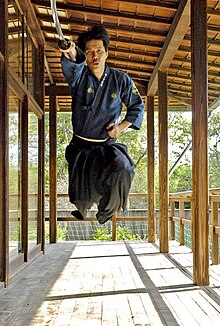Iaijutsu
 |
|
| Focus | Swordsmanship |
|---|---|
| Hardness | Non-competitive |
| Country of origin |
|
| Creator | In the Nara period (710-794). |
| Parenthood | - |
| Olympic sport | No |
Iaijutsu (居合術?), is a combative quick-draw sword technique. This art of drawing the Japanese sword, katana, is one of the Japanese koryū martial art disciplines in the education of the classical warrior (bushi).
Iaijutsu is a combative sword-drawing art but not necessarily an aggressive art because iaijutsu is also a counterattack-oriented art. Iaijutsu technique may be used aggressively to wage a premeditated surprise attack against an unsuspecting enemy. The formulation of iaijutsu as a component system of classical bujutsu was made less for the dynamic situations of the battlefield than for the relatively static applications of the warrior's daily life off the field of battle. .
Historically, it is unclear when the term "iaijutsu" accurately performed, and when techniques to draw katana from the scabbard was first practiced as decided form of exercise. The Japanese sword has existed since the Nara period (710-794), where techniques to draw the sword have been practiced under other names than 'iaijutsu'. The term 'iaijutsu' was first verified in connection with Iizasa Chōisai Ienao (c. 1387 - c. 1488), founder of the school Tenshin Shōden Katori Shintō-ryū.
Archaeological excavations dated the oldest sword in Japan from at least as early as second century B.C. The Kojiki (Record of Ancient Matters) and the Nihon Shoki (History of Japan), ancient texts on early Japanese history and myth that were compiled in the eighth century A.D., describe iron swords and swordsmanship that pre-date recorded history, attributed to the mythological age of the gods (kami).
...
Wikipedia
